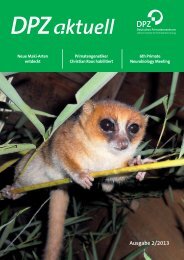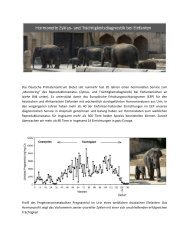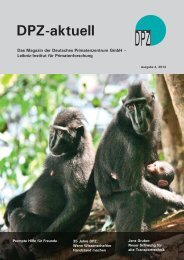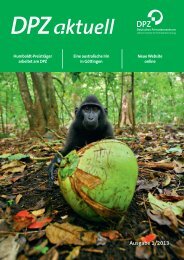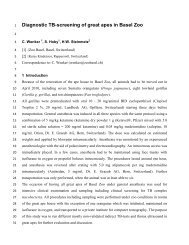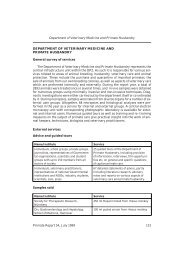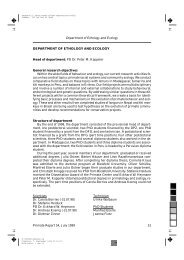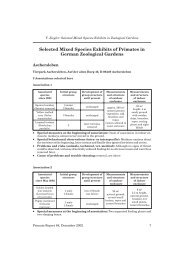Vol. 15 - Deutsches Primatenzentrum
Vol. 15 - Deutsches Primatenzentrum
Vol. 15 - Deutsches Primatenzentrum
You also want an ePaper? Increase the reach of your titles
YUMPU automatically turns print PDFs into web optimized ePapers that Google loves.
Page 68 Lemur News <strong>Vol</strong>. <strong>15</strong>, 2010<br />
human-induced fire nearby Andasivodihazo,one of the forest<br />
fragments at Tsinjoarivo (Fig. 1). At the time, "May" was believed<br />
to be, as were all eastern rainforest dwarf lemurs, C.<br />
major. Unfortunately, this female could not fully recover and<br />
died soon after the salvage, but her skeletal remains were<br />
carefully preserved and stored at the University of Antananarivo<br />
by Irwin’s team. Seven years later this specimen came<br />
to play a key role in our morphological analysis of dwarf<br />
lemurs at Tsinjoarivo.<br />
Fig.1: Map showing Tsinjoarivo and other localities associated<br />
with Sibree’s dwarf lemurs; see text for details.<br />
In 2006, with the logistic help of Mitchell Irwin and Jean-Luc<br />
Raharison, I began a survey of nocturnal lemurs at Tsinjoarivo.<br />
My assistants and I successfully trapped dwarf lemurs<br />
at two study sites: in one of the forest fragments (Andasivodihazo,<br />
19º41’<strong>15</strong>"S, 47º46’25"E, 1660 m) and within continuous<br />
forest (Vatateza, 19º43’<strong>15</strong>"S, 47º51’25"E, 1396 m)<br />
(Blanco et al., 2009). Even to an inexperienced eye, fragment<br />
dwarf lemurs looked different from continuous forest individuals,<br />
in that they were overall smaller, with grayer fur,<br />
marked eye rings and significantly larger female genitalia (Fig.<br />
2). Our morphological and dental analyses determined that<br />
of all the species described by Groves,C.sibreei was the most<br />
similar to forest fragment dwarf lemurs (Blanco et al., 2009).<br />
(Hopefully, sampling of C.sibreei’s holotype will be allowed in<br />
the near future to definitely determine whether or not there<br />
is a genetic match between this specimen and fragment<br />
dwarf lemurs from Tsinjoarivo.) Recent genetic analyses<br />
have confirmed not only that dwarf lemurs from Andasivodihazo<br />
constitute a different clade (and therefore an independent<br />
phylogenetic lineage), but also that the fragment<br />
dwarf lemur species had branched off first and was ancestral<br />
to the other dwarf lemur species (Groeneveld et al., 2010).<br />
To date, no other living population of C. sibreei has been<br />
reported in the wild and more intensive surveys around the<br />
Tsinjoarivo area (including possibly remaining forests nearby<br />
Ankeramadinika, ~100 km from Tsinjoarivo) are warranted<br />
to assess geographic boundaries and population density.<br />
Fig.2: Sibree’s dwarf lemur captured at Andasivodihazo, one<br />
of the forest fragments at Tsinjoarivo.<br />
Conservation concerns<br />
The genetic confirmation of three clades corresponding to C.<br />
medius, C. major and C. crossleyi, each of which has broad<br />
geographic distributions, implied that dwarf lemurs might be<br />
less threatened than previously thought (Groeneveld et al.,<br />
2009). However, the situation for C. sibreei is radically different.<br />
Tsinjoarivo’s unique geographic setting, continuous<br />
with the central plateau on the west and the steep escarpment<br />
of rainforest in the east, may harbor a unique array of<br />
animal communities. To date, C. sibreei has been captured in<br />
sympatry with C. crossleyi at one forest fragment, Andasivodihazo,and<br />
at one intermediate location,Ankadivory.Both of<br />
these areas are subjected to illicit logging and heavy deforestation<br />
(Fig.3).Furthermore,these forest sites are located towards<br />
Tsinjoarivo’s western boundary which reaches some<br />
of the highest altitudes (up to ~1650 m) known in eastern<br />
Fig. 3: Example of logging near Ankadivory, one of the forest<br />
sites where Sibree’s dwarf lemurs were captured.





